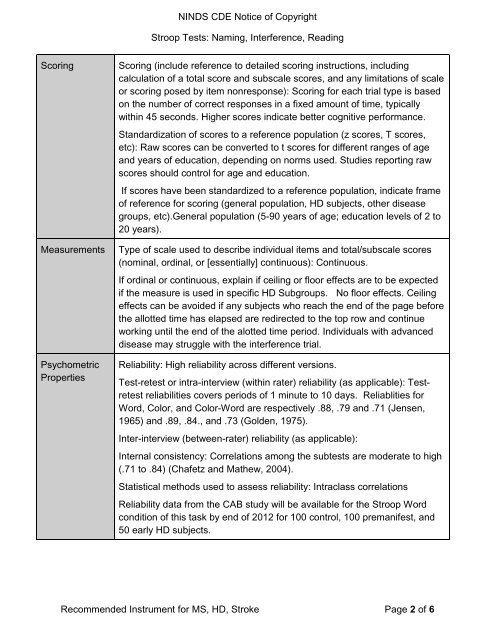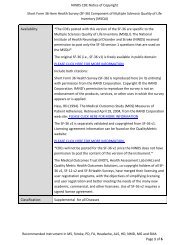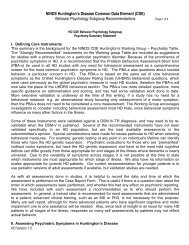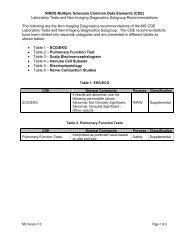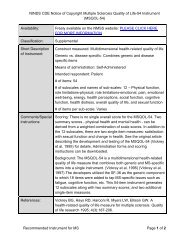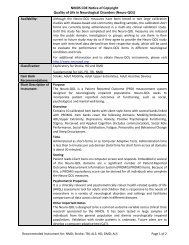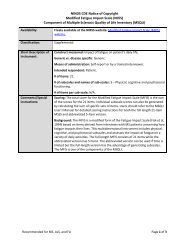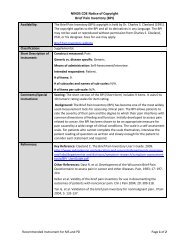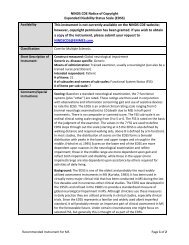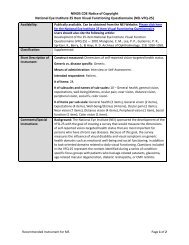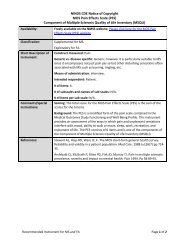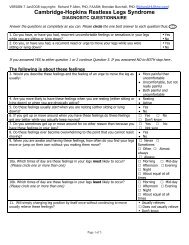NOC - NINDS Common Data Elements
NOC - NINDS Common Data Elements
NOC - NINDS Common Data Elements
You also want an ePaper? Increase the reach of your titles
YUMPU automatically turns print PDFs into web optimized ePapers that Google loves.
<strong>NINDS</strong> CDE Notice of Copyright<br />
Stroop Tests: Naming, Interference, Reading<br />
Scoring<br />
Measurements<br />
Psychometric<br />
Properties<br />
Scoring (include reference to detailed scoring instructions, including<br />
calculation of a total score and subscale scores, and any limitations of scale<br />
or scoring posed by item nonresponse): Scoring for each trial type is based<br />
on the number of correct responses in a fixed amount of time, typically<br />
within 45 seconds. Higher scores indicate better cognitive performance.<br />
Standardization of scores to a reference population (z scores, T scores,<br />
etc): Raw scores can be converted to t scores for different ranges of age<br />
and years of education, depending on norms used. Studies reporting raw<br />
scores should control for age and education.<br />
If scores have been standardized to a reference population, indicate frame<br />
of reference for scoring (general population, HD subjects, other disease<br />
groups, etc).General population (5-90 years of age; education levels of 2 to<br />
20 years).<br />
Type of scale used to describe individual items and total/subscale scores<br />
(nominal, ordinal, or [essentially] continuous): Continuous.<br />
If ordinal or continuous, explain if ceiling or floor effects are to be expected<br />
if the measure is used in specific HD Subgroups. No floor effects. Ceiling<br />
effects can be avoided if any subjects who reach the end of the page before<br />
the allotted time has elapsed are redirected to the top row and continue<br />
working until the end of the alotted time period. Individuals with advanced<br />
disease may struggle with the interference trial.<br />
Reliability: High reliability across different versions.<br />
Test-retest or intra-interview (within rater) reliability (as applicable): Testretest<br />
reliabilities covers periods of 1 minute to 10 days. Reliablities for<br />
Word, Color, and Color-Word are respectively .88, .79 and .71 (Jensen,<br />
1965) and .89, .84., and .73 (Golden, 1975).<br />
Inter-interview (between-rater) reliability (as applicable):<br />
Internal consistency: Correlations among the subtests are moderate to high<br />
(.71 to .84) (Chafetz and Mathew, 2004).<br />
Statistical methods used to assess reliability: Intraclass correlations<br />
Reliability data from the CAB study will be available for the Stroop Word<br />
condition of this task by end of 2012 for 100 control, 100 premanifest, and<br />
50 early HD subjects.<br />
Recommended Instrument for MS, HD, Stroke Page 2 of 6


